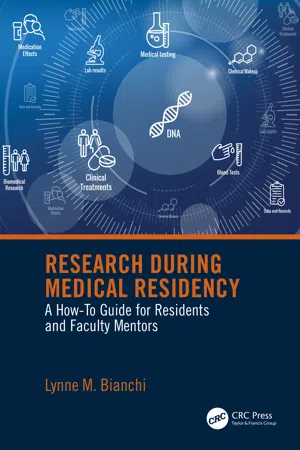
Research During Medical Residency
A How to Guide for Residents and Faculty Mentors
- 306 pages
- English
- ePUB (mobile friendly)
- Available on iOS & Android
About This Book
This book is a guide for medical residents and faculty in the fundamentals of clinical research, publication practices, and conference skills. It offers advice on how to incorporate scholarly activities into training routines, so the process becomes more manageable and less burdensome. Suggestions for pursuing other scholarly activities, outside of clinical research, are also offered.
Participation in research and other scholarly activities is a requirement for graduation from medical residency programs in the United States and many other countries. Faculty physicians who train residents are also required to produce annual scholarly work. Adding scholarship onto an already long list of requirements often feels a bit daunting to medical residents and the faculty who teach them. Fortunately, there are many forms of scholarly activity, including basic and clinical research, quality improvement projects, and educational assessments, so everyone can find interesting and feasible projects to complete.
This valuable reference provides users with a reliable source to turn to whenever they have questions on how to develop, conduct, publish, or present a research project. Written with the perspective of busy faculty and residents in mind, the content balances the need for enough detail to be instructive with the need for quick access to key points.
Frequently asked questions
Information
Chapter 1 Introduction: Developing Ways to Incorporate Scholarly Activity into Clinical Training and Practice
- Choose a form of scholarly activity that fits your personality, interests, and resources.
- Develop projects that are attractive to you and beneficial to your field.
- Design studies that can be completed given your available resources.
- Spend time reading the literature.
- It takes a bit of effort to develop an idea into a worthwhile project.
- Ideas are revised multiple times before implementing a project.
Box 1.1 The Many Forms of Scholarly Activities: Choose What Works for You and Plan AccordinglyIn addition to clinical research, scholarly activities include quality improvement (QI) or quality assurance (QA) projects, and education assessments (see References and Resources).In the United States, the Accreditation Council for Graduate Medical Education (ACGME) requires annual scholarly activity reports from residents and their faculty mentors (Tables 1.1 and 1.2). Programs in other countries have their own guidelines and requirements.
Table 1.1 ACGME Resident Scholarly Activities All residents and fellows must participate in scholarly activity prior to graduation. Six categories of scholarly activity are recorded for each resident or fellow annually. The identification number(s) for publications cited in PubMed (the PMID) are listed, and the total number of other publications and the number of presentations at regional, national, or international conferences are reported. Whether the resident participated in research or teaching is also noted.
Table 1.2 ACGME Faculty Scholarly Activities
1.1 Turn Your Interests into Scholarly Work
Consider the Questions You Ask and the Interests You Have
Table of contents
- Cover
- Half-Title
- Title
- Copyright
- Dedication
- Contents
- PREFACE
- ACKNOWLEDGMENTS
- CONTRIBUTORS
- 1 INTRODUCTION: DEVELOPING WAYS TO INCORPORATE SCHOLARLY ACTIVITY INTO CLINICAL TRAINING AND PRACTICE
- 2 LITERATURE SEARCHES: FINDING WHAT IS KNOWN AND UNKNOWN ABOUT A TOPIC
- 3 CRITICALLY READING RESEARCH ARTICLES: FORMING OPINIONS AND INTERPRETING DATA
- 4 BASIC RESEARCH DESIGN: DEVELOPING RESEARCH IDEAS INTO MEANINGFUL PROJECTS
- 5 THE STUDY POPULATION: FINDING AND ENROLLING PARTICIPANTS THAT FIT THE STUDY QUESTION
- 6 COLLECTING DATA YOU CAN TRUST
- 7 PREPARING STUDIES FOR STATISTICAL ANALYSIS
- 8 RESEARCH WITH HUMAN SUBJECTS: PREPARING AN APPLICATION FOR THE INSTITUTIONAL REVIEW BOARD
- 9 OBTAINING INFORMED CONSENT FOR RESEARCH STUDIES
- 10 MEDICAL WRITING: TIPS FOR PREPARING CLEAR, CONCISE DOCUMENTS FOR YOUR AUDIENCE
- 11 MEDICAL WRITING: JOURNAL RESEARCH ARTICLES
- 12 MEDICAL WRITING: CASE STUDIES
- 13 WRITING SUCCESSFUL GRANT PROPOSALS: TO FIT THE MISSION OF THE FUNDING AGENCY
- 14 WRITING BOOK CHAPTERS
- 15 ATTENDING AND PRESENTING AT SCIENTIFIC CONFERENCES: COMMON ELEMENTS
- 16 PREPARING AND GIVING EFFECTIVE POSTER PRESENTATIONS
- 17 PREPARING AND GIVING EFFECTIVE ORAL PRESENTATIONS
- 18 ORGANIZING A SUCCESSFUL LOCAL OR REGIONAL CONFERENCE
- INDEX